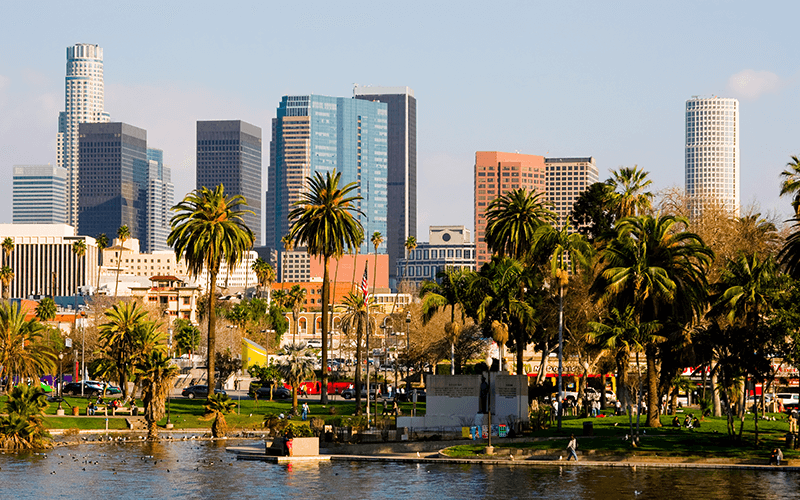Last time, I suggested the following rules for prioritizing development:
1. Locations should be centrally located in a high population area. Important to think in terms of traditional and electric bikes, as well as other micromobility options in addition to public transportation (particularly buses). The object is to have access to the widest possible range of jobs, shops, schools, etc. Sites cut off in one direction by mountains or large bodies of water are always sub-optimal.
2. And well served by EXISTING public transportation. Ideally within walking distance of a major hub like Union Station. Failing that, directly connected to one of these hubs by rail or rapid bus lines. Think North Hollywood. Particularly if not served by a good metro line, it needs a good selection of reasonably high frequency bus routes going north, south, east and west. Think Echo Park.
3 Given the costs and carbon footprint of construction, we should avoid sites that are viable now but which probably won’t be in the near future.
a. For coastal cities, elevation should be at least twenty feet. For areas prone to storm surges (pretty much everywhere back East), add another twenty feet to that. Given the economic and environmental costs of building and demolishing large structures, it makes no sense to put them in locations that will be underwater by 2050.
3b. For cities in the West, areas with high risk of megafires should be avoided. In addition to the obvious importance of not putting people in harms way, keeping housing out of burn zones makes essential controlled and managed burns easier. At the very least, we shouldn't have policies that encourage development in Western wildland-urban interfaces.
4. Money matters. Developable land matters. Constraints matter. Magnitude matters. None of the distributions are uniform. The costs of increasing density by, say, a couple of thousand people per square mile varies wildly from town to town and neighborhood to neighborhood.
How do these rules align with where the YIMBYs focus their efforts, attention and political capital?
The three areas that have long been in heavy rotation with the California YIMBYs are, in order, San Francisco, Santa Monica and Venice Beach. Trailing the pack, the NYT has singled out La Cañada Flintridge and Matt Yglesias did a post on Beverly Hills. I'm not cherry-picking here, at least not consciously. With the possible exception of some gentrification battles in majority-minority neighborhoods like Boyle Heights, these are all the places that come to mind.
San Francisco is one of the worst places in the Bay Area to build if you want to alleviate the housing crisis and reduce commuting. It's an hour and a half from the population and employment hub of San Jose and Silicon Valley. Geographically, it's an isolated postage stamp (though still far larger than any of the other cities/neighborhoods on this list). Even if you could build up every one of its forty-seven square miles (and, of course, you can't), you'd still have a trivial impact on housing compared to similar development in larger and much less dense towns such Oakland and, yes, San Jose. There's always the chance that new housing will attract more Silicon Valley tech workers willing to make the hellish commute in order to have a cool zip code. Just the opposite of the outcome we're hoping for and already a problem.
While the fixation on San Francisco is odd, the focus on Santa Monica and Venice is simply bizarre. Tiny (covering combined about twelve of LA County’s four thousand square miles), out-of-the-way, cut off by ocean to the west and mountains to the north. Scoring miserably on places readily accessible by public transit (the E line is terrible though proposed upgrades may improve this somewhat). A big chunk of SM is designated a wildland-urban interface. Venice, while safe from fires, is one of the few parts of LA low lying enough to be threatened by rising sea levels.
La Cañada Flintridge, in addition to being tiny and isolated, is almost uniquely menaced by megafires with wild-land on both north and south.
Beverly Hills may be the leper with the most fingers here, but it is still very small (<6 square miles), not centrally located, cut off to the north by hills and canyons, and obscenely expensive. [I hope I’m anything on this last one. BH is one of the parts of LA I’ve explored the least. It’s not a very interesting place.]
To summarize, when you put aside gentrification of black, Latino and Asian neighborhoods, practically all of the discussion of of the villainy of California’s anti-density NIMBYs and the heroism of the YIMBYs has focused on pieces of land that are vanishingly small and situated in some of the worst spots imaginable for development.
This is not a coincidence. It is a direct result an overly appealing but fundamentally flawed narrative combined with fatally misaligned market forces and a dollop of NYT toxic provincialism (I expect so much better from Paul Krugman). The quality of the discussion is so badly thought out and relentlessly trivial that it is next to impossible for serious solutions to get any traction.
Next time, why things are so bad (after a rebuttal from Joseph).










